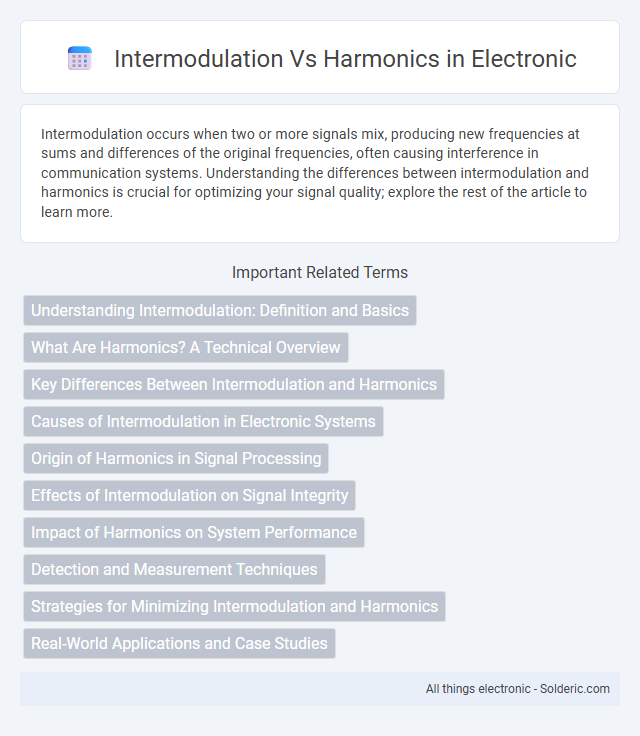Intermodulation occurs when two or more signals mix, producing new frequencies at sums and differences of the original frequencies, often causing interference in communication systems. Understanding the differences between intermodulation and harmonics is crucial for optimizing your signal quality; explore the rest of the article to learn more.
Comparison Table
| Aspect | Intermodulation | Harmonics |
|---|---|---|
| Definition | New frequencies created by mixing two or more signals | Multiples of a fundamental frequency generated by a signal |
| Frequency Generation | Sum and difference of original signal frequencies | Integer multiples (2nd, 3rd, etc.) of the fundamental frequency |
| Signal Source | Two or more different frequencies | Single fundamental frequency |
| Cause | Non-linear system components mixing multiple signals | Non-linear distortion of a single signal |
| Impact on Systems | Interference, signal degradation in communication systems | Distortion, reduced signal quality and efficiency |
| Common in | RF communication, audio systems, amplifiers | Amplifiers, oscillators, audio equipment |
Understanding Intermodulation: Definition and Basics
Intermodulation occurs when two or more signals mix within a nonlinear system, producing new frequencies that are sums and differences of the original frequencies, which can interfere with your desired signal. Unlike harmonics, which are integer multiples of a single frequency generated by nonlinearities in a device, intermodulation products arise specifically from interactions between multiple frequencies. Understanding the basics of intermodulation helps in diagnosing signal distortion and improving communication system performance.
What Are Harmonics? A Technical Overview
Harmonics are integer multiples of a fundamental frequency generated within electrical or audio systems due to nonlinearities, often causing distortion and signal degradation. They arise when a primary frequency interacts with system components, producing frequencies at 2x, 3x, or higher multiples of the original tone. Understanding harmonics is essential for optimizing Your system's performance, especially in power quality and audio clarity applications.
Key Differences Between Intermodulation and Harmonics
Intermodulation occurs when two or more different frequencies mix in a nonlinear system, producing new frequencies that are sums and differences of the originals, while harmonics are integer multiples of a single fundamental frequency generated by nonlinearities. Intermodulation distortion typically affects communication systems by introducing unwanted signals that interfere with the original channels, whereas harmonic distortion mainly causes signal distortion by adding overtone frequencies. Understanding these differences helps you optimize signal integrity and minimize interference in RF and audio applications.
Causes of Intermodulation in Electronic Systems
Intermodulation in electronic systems arises when two or more signals mix within a nonlinear device, such as amplifiers or mixers, causing the generation of unwanted frequencies that are combinations of the original signals' frequencies. Unlike harmonics, which are integer multiples of a single signal's frequency caused mainly by distortion in a single signal path, intermodulation products result specifically from the interaction of multiple signals. Understanding and minimizing these nonlinearities in your electronic components is essential to reduce intermodulation interference and maintain signal integrity.
Origin of Harmonics in Signal Processing
Harmonics in signal processing originate from nonlinearities within a system or device, where an input signal with a fundamental frequency generates integer multiples of that frequency. These harmonic frequencies result from distortion caused by components such as amplifiers, mixers, or imperfect transmission lines. Understanding harmonics is essential for minimizing signal degradation and ensuring your system maintains signal integrity and clarity.
Effects of Intermodulation on Signal Integrity
Intermodulation causes unwanted frequency components by mixing two or more signals, generating spurious frequencies that degrade signal integrity and cause interference within communication systems. These intermodulation products reduce the signal-to-noise ratio, leading to distortion and decreased overall system performance. Unlike harmonics, which are multiples of a single signal frequency, intermodulation arises from nonlinear interactions of multiple frequencies, making it more complex to manage in multi-carrier environments.
Impact of Harmonics on System Performance
Harmonics cause distortion in power systems by introducing frequencies that are integer multiples of the fundamental frequency, resulting in increased losses, overheating of equipment, and malfunction of sensitive devices. These harmonic distortions degrade power quality, leading to reduced efficiency and potential damage to motors, transformers, and electronic components. Proper harmonic mitigation techniques, such as filters and tuned reactors, are essential to maintain optimal system performance and extend equipment lifespan.
Detection and Measurement Techniques
Detection and measurement of intermodulation and harmonics require specialized equipment such as spectrum analyzers and network analyzers to accurately identify frequency components and amplitude levels. Intermodulation distortion is typically evaluated using two-tone test signals and analyzing the appearance of combination frequencies, whereas harmonics are measured by applying a single-tone input and quantifying integer multiples of the fundamental frequency. Advanced techniques like vector signal analysis and digital signal processing enhance precision in separating and quantifying intermodulation products from harmonic distortion in complex RF and audio systems.
Strategies for Minimizing Intermodulation and Harmonics
Minimizing intermodulation and harmonics involves the use of high-quality filtering techniques, such as bandpass and low-pass filters, to suppress unwanted frequency components. Employing linear amplifiers and maintaining proper impedance matching in RF systems reduce nonlinear distortion that generates intermodulation products and harmonic frequencies. Careful circuit design, including shielding and grounding practices, helps prevent signal coupling and interference, further lowering intermodulation and harmonic distortion levels.
Real-World Applications and Case Studies
Intermodulation and harmonics play critical roles in real-world applications such as wireless communication, audio engineering, and radar systems, where signal integrity and clarity are paramount. Intermodulation products arise from nonlinear interactions between multiple frequencies, causing interference that can degrade performance in cellular networks and satellite transmissions. Understanding these effects through case studies enables you to design more robust systems that minimize distortion and optimize signal quality.
Intermodulation vs harmonics Infographic

 solderic.com
solderic.com